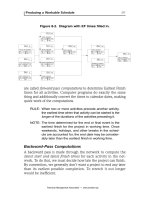IT project management 3rd by THompson chappter 05
Bạn đang xem bản rút gọn của tài liệu. Xem và tải ngay bản đầy đủ của tài liệu tại đây (716.42 KB, 43 trang )
Chapter 5:
Project Scope Management
Learning Objectives
• Understand the elements that make good project scope
management important
• Describe the strategic planning process, apply different project
selection methods, such as a net present value analysis, a
weighted scoring model, and a balanced scorecard, and
understand the importance of creating a project charter
• Explain the scope planning process and contents of a scope
statement
Learning Objectives
• Discuss the scope definition process and construct a work
breakdown structure using the analogy, top-down, bottom-up,
and mind mapping approaches
• Understand the importance of scope verification and scope
change control to avoid scope creep on information technology
projects
• Describe how software can assist in project scope management
What is Project Scope Management?
• Scope refers to all the work involved in creating the products of
the project and the processes used to create them. It defines
what is or is not to be done
• Deliverables are products produced as part of a project, such as
hardware or software, planning documents, or meeting minutes
• The project team and stakeholders must have the same
understanding of what products will be produced as a result of a
project and how they’ll be produced
Project Scope Management Processes
• Initiation: beginning a project or continuing to the next phase
• Scope planning: developing documents to provide the basis
for future project decisions
• Scope definition: subdividing the major project deliverables
into smaller, more manageable components
• Scope verification: formalizing acceptance of the project
scope
• Scope change control: controlling changes to project scope
Project Initiation: Strategic Planning
and Project Selection
• The first step in initiating projects is to look at the big picture or
strategic plan of an organization
• Strategic planning involves determining long-term business
objectives
• IT projects should support strategic and financial business
objectives
Table 5-1. Why Firms Invest in
Information Technology
Identifying Potential Projects
• Many organizations follow a planning process for selecting IT
projects
• First develop an IT strategic plan based on the organization’s
overall strategic plan
• Then perform a business area analysis
• Then define potential projects
• Then select IT projects and assign resources
Figure 5-1. Information
Technology Planning Process
Methods for Selecting Projects
• There are usually more projects than available time and
resources to implement them
• It is important to follow a logical process for selecting IT
projects to work on
• Methods include:
– focusing on broad needs
– categorizing projects
– performing financial analyses
– using a weighted scoring model
– implementing a balanced scorecard
Focusing on Broad
Organizational Needs
• It is often difficult to provide strong justification for many IT
projects, but everyone agrees they have a high value
• “It is better to measure gold roughly than to count pennies
precisely”
• Three important criteria for projects:
– There is a need for the project
– There are funds available
– There’s a strong will to make the project succeed
Categorizing IT Projects
• One categorization is whether the project addresses
– a problem
– an opportunity
– a directive
• Another categorization is how long it will take to do and when it
is needed
• Another is the overall priority of the project
Financial Analysis of Projects
• Financial considerations are often an important consideration in
selecting projects
• Three primary methods for determining the projected financial
value of projects:
– Net present value (NPV) analysis
– Return on investment (ROI)
– Payback analysis
Net Present Value Analysis
• Net present value (NPV) analysis is a method of calculating the
expected net monetary gain or loss from a project by discounting
all expected future cash inflows and outflows to the present point
in time
• Projects with a positive NPV should be considered if financial
value is a key criterion
• The higher the NPV, the better
Uses
Excel’s
npv
function
Net Present Value Example
Note
that
totals
are
equal,
but
NPVs
are
not.
Multiply
by the
discount
rate each
year, then
take cum.
benefits –
costs to
get NPV
JWD Consulting NPV Example
NPV Calculations
• Determine estimated costs and benefits for the life of the project
and the products it produces
• Determine the discount rate (check with your organization on
what to use)
• Calculate the NPV (see text for details)
• Notes: Some organizations consider the investment year as year
0, while others start in year 1. Some people enter costs as
negative numbers, while others do not. Check with your
organization for their preferences.
Return on Investment
• Return on investment (ROI) is calculated by subtracting the
project costs from the benefits and then dividing by the costs
ROI = (total discounted benefits - total discounted
costs) / discounted costs
• The higher the ROI, the better
• Many organizations have a required rate of return or minimum
acceptable rate of return on an investment
• Internal rate of return (IRR) can by calculated by setting the
NPV to zero
Payback Analysis
• Another important financial consideration is payback analysis
• The payback period is the amount of time it will take to recoup,
in the form of net cash inflows, the net dollars invested in a
project
• Payback occurs when the cumulative discounted benefits and
costs are greater than zero
• Many organizations want IT projects to have a fairly short
payback period
Charting the Payback Period
Weighted Scoring Model
• A weighted scoring model is a tool that provides a systematic
process for selecting projects based on many criteria
– First identify criteria important to the project selection process
– Then assign weights (percentages) to each criterion so they add up
to 100%
– Then assign scores to each criterion for each project
– Multiply the scores by the weights and get the total weighted scores
• The higher the weighted score, the better
• See “What Went Right?” for a description of how a mortgage
finance agency uses a weighted scoring model for IT projects
Figure 5-5. Sample Weighted Scoring
Model for Project Selection
Implementing a Balanced
Scorecard
• Drs. Robert Kaplan and David Norton developed this approach
to help select and manage projects that align with business
strategy
• A balanced scorecard converts an organization’s value drivers,
such as customer service, innovation, operational efficiency, and
financial performance to a series of defined metrics
• See www.balancedscorecard.org for more information
Project Charters
• After deciding what project to work on, it is important to
formalize projects
• A project charter is a document that formally recognizes the
existence of a project and provides direction on the project’s
objectives and management
• Key project stakeholders should sign a project charter to
acknowledge agreement on the need and intent of the project
Sample Project Charter









